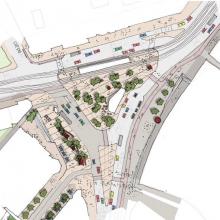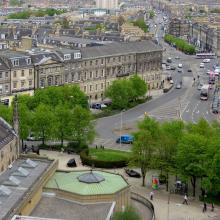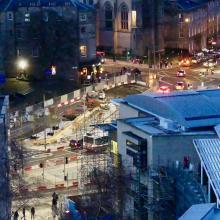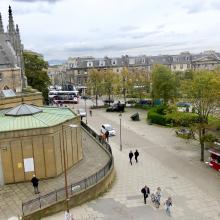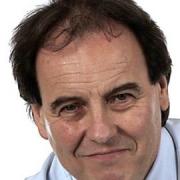
Trevor Davies, formerly Edinburgh Council's Planning Convener (2003–2007) and now Honorary Professor of Urban Studies at Glasgow University, has been rather quiet of late about Picardy Place. Today, he breaks his silence.
Let’s take a step back
It is Edinburgh’s topography, its built heritage and its status as capital city that have attracted the skills and learning and investment which together make our city prosperous and of worldwide renown.
Being prosperous means we have lots of traffic. And the very things that make us prosperous make the management and planning of that traffic difficult. Our traffic planners have needed to respond with care and imagination.
One time when they didn’t – in the 1960s – the eventually aborted ‘inner ring road’, planned to slice through the Meadows, Calton Hill and the New Town, left the present unlovely roundabout at Picardy Place in its wake.

It contributes nothing to the city other than a traffic interchange. The large empty spaces contribute no economic value to the city, its ‘green’ spaces offer little useable public value and as a whole it detracts from rather than supports the ‘outstanding universal values’ of World Heritage.
In a compact and populous city like Edinburgh we can’t afford to sustain value-less space. The fundamental question is therefore this: How do we take this once-in-a-century opportunity and redesign Picardy Place to create value for all its users?
Sustainable value
How do we create sustainable economic and commercial value that make a city prosperous? We provide for increased pedestrian footfall through easy access and connectivity.
The tramstop and bus routes will bring people here, so will good safe footways from nearby car parks. Useable green spaces and active frontages with shops/cafes will encourage them to linger.
Civic and public values
How do we create and sustain the civic and public values – safety, diversity, liveliness, cleanliness, mobility, identity – that make city life worth living?
Strangely, it turns out they are much the same: easy access and connectivity, green spaces and active frontages. I’d then add one extra useful principle – if we make mobility, access and use safe and good for disabled people then it will be excellent for the rest of us.
Further, we sustain and add to the ‘outstanding universal values’ of World Heritage through careful, sensitive architecture and by paying attention to the future – addressing in one place the global issues of gross inequality and climate protection.
The current proposals for Picardy Place – which essentially are about expanding and changing the shape of today's traffic roundabout and putting some buildings in the middle – do not answer my questions about creating value for all its users.
If they did we would probably already have seen proposals come forward over the years for putting buildings, kiosks and a public park inside the current roundabout. We haven’t.
The long view
The difficulties go back to 2009 when the Picardy Place Design Principles, approved by the then Planning Committee, concluded with this diagram.
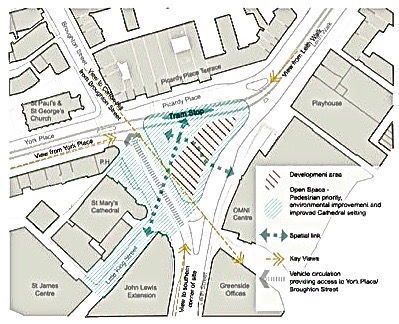
Though rightly extending the open space-pedestrian priority area from Little King Street to Leith Walk, it nevertheless snuck in a direct traffic access to York Place and Broughton Street.
Leaving that conflict of uses unresolved gave the opportunity today to essentially remove the open space-pedestrian priority designation and to move on to the traffic engineers’ favourite of one-way three-lane urban roads with, no doubt, street railings to protect and cage pedestrians.
Prioritising pedestrians
It is time to go back to this diagram of planning principles and resolve that conflict in favour of increased values for all its users – and that means in favour of the open space-pedestrian priority area.
If it takes a little more time and thought it’s worth it – it’s going to be there for a hundred years.
Got a view? Tell us at spurtle@hotmail.co.uk and @theSpurtle and Facebook
------------------
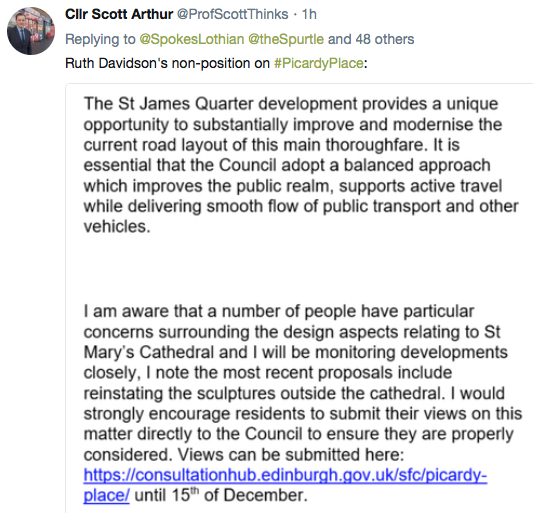

Below is the text of a press release issued on 7 December by the Living Streets Edinburgh Group.
PEDESTRIAN CAMPAIGNERS CALL FOR PICARDY PLACE GYRATORY TO BE REPLACED BY 'PEOPLE-FRIENDLY' SOLUTION
Local pedestrian campaigners have urged the City Council to scrap the proposed gyratory roundabout at Picardy Place and replace it with a ‘people-friendly’ street layout. In its formal submission [1] to the Council’s consultation on the controversial traffic proposals for the Picardy Place area, Living Streets Edinburgh Group [2], argues that the gyratory is ‘entirely inconsistent with the Council’s own strategic transport objectives for the city centre and Edinburgh as a whole’ and should be scrapped in favour of expanded public space, wider pavements, and more direct road crossings linking bus stops and a future tram stop with the new St James Centre development. The Group’s Convenor, David Spaven, said:
‘The current Picardy Place scheme is a traffic plan – but it should be a people-friendly plan. We are urging the Council to work towards a design which is both a symbolic and very practical demonstration of the importance of walking and ‘place’ rather than ‘movement’, in this highly-visible and much-used area of the city centre and World Heritage Site.
‘The Council have an overall aim of reducing the car’s share of Edinburgh’s transport [3] – but sticking with a three-lane gyratory at the heart of the city around Picardy Place would simply encourage yet more car traffic. And London has a comprehensive programme for removing major gyratory roundabouts, due to their impacts on pedestrians and cyclists. It would be tragic if Edinburgh were to head in the opposite direction, endorsing dis-credited 1960s approaches to urban transport planning.’
Other measures in the group’s recommendations to the Council include:
- exploring options for bus-only access on the south section of Leith Street
- redesign of pedestrian crossings to provide high-quality connectivity along pedestrian ‘desire lines’
- ensuring that all footways meet the Street Design Guidance ‘desirable minimum’ width of 4 metres or more
- eliminating ‘shared space’ for pedestrians and cyclists, replaced by segregated provision
- moving segregated cycleways out of the centre of footways, relocating them between the footway and the carriageway.
NOTES FOR EDITORS:
[1] Living Streets Edinburgh Group consultation response is attached.
[2] Living Streets Edinburgh Group is the local voluntary arm of the national charity campaigning for better conditions for ‘everyday’ walking. See: http://www.livingstreetsedinburgh.org.uk/about/about-living-streets/
[3] The City of Edinburgh Council’s ‘Local Transport Strategy 2014-2019’ refers to ‘reducing the need for motorised travel, especially car travel. Less car traffic helps make a city a safer and more pleasant place to live, as well as an attractive place to invest.’ This qualitative objective is reinforced by a specific quantitative aim to reduce the car’s share of all vehicular traffic on the city’s streets from 42% in 2010 to 29% in 2020.
END OF RELEASE

